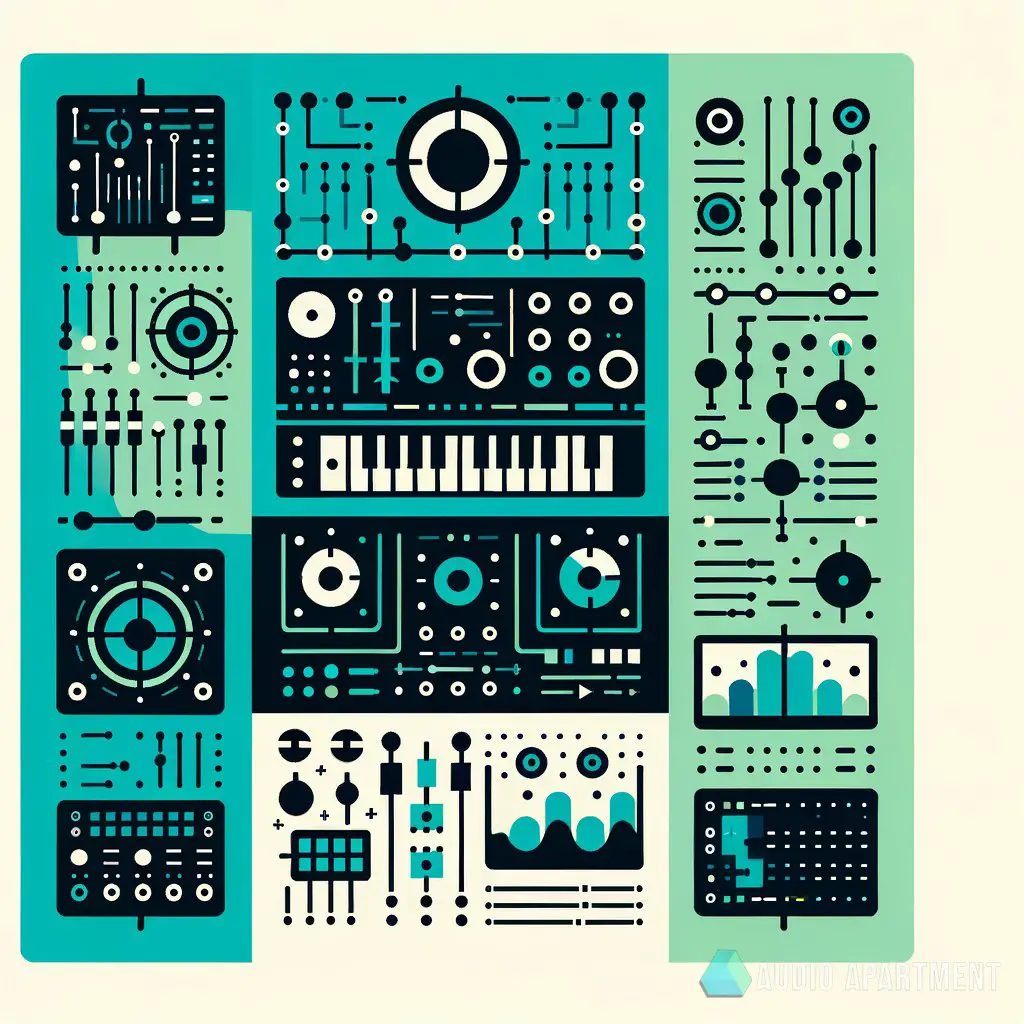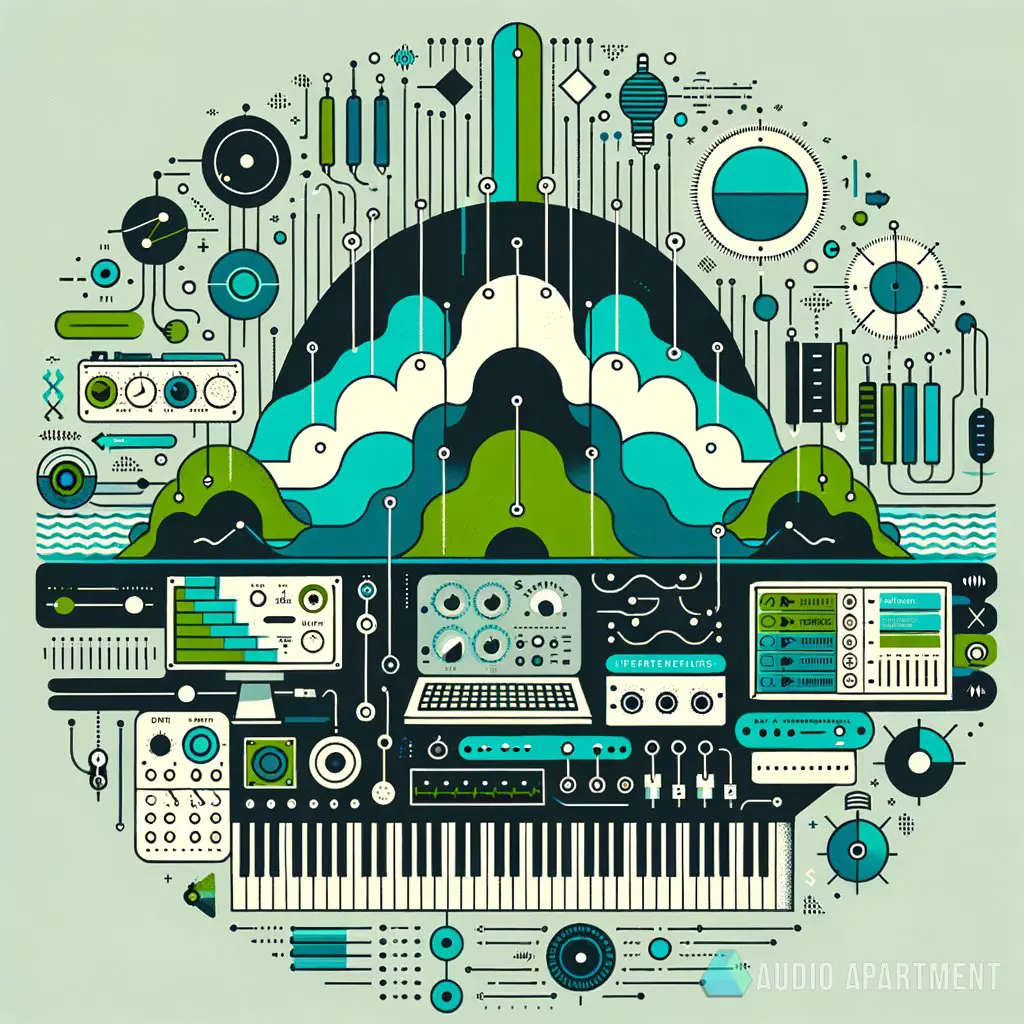In the heated debates over studio setup supremacy, knowing the difference between gear like the must-have studio monitors for mixing precision and the comfort of top-tier headphones can be a game-changer. Why do the basics of synthesis matter so much for sound design? We’ll dive into the essential concepts that lay the foundation for crafting those epic soundscapes.
If you are a visual learner, check out this video titled ‘Sound Design and Synth Fundamentals’
Key takeaways
- Oscillators are the foundational sound sources in synthesis.
- Filters shape the frequency content and character of sounds.
- Envelopes dictate the dynamic evolution of a sound over time.
- LFOs introduce movement and modulation into static sounds.
What key elements create the core of sound synthesis?
Decoding the language of synthesis is like unlocking a secret realm where waveforms shape the music we love. From the throb of a bassline to the shimmer of a hi-hat, it’s these fundamentals that let us sculpt sounds from the ether.

Here’s an extensive dive into the key elements you’ll need to master for sonic alchemy in sound design.
1. Oscillators
Oscillators are the heartthrob of any synthesizer; they’re your raw sound source, akin to the strings of a guitar. Whether it’s analog or digital, an oscillator generates basic waveforms—sine, square, sawtooth, and triangle.
Each has a distinct tone: sine waves are smooth and pure, while square waves have a hollow, reedy character. This is your starting block, the canvas upon which you’ll paint your audio masterpiece, and understanding these will truly change how you approach sound design.
Dive into why analog warmth affects digital recordings to see the interplay of these elemental sounds with different recording mediums.
Oscillators can be layered, modulated, and tweaked to create complex timbres and textures. They’ll require your careful attention as you step into synthesis because how you combine and manipulate these waveforms determines the uniqueness of your sound—or if you’re crafting something that truly slaps or if it just falls flat.
Explore the magic of oscillators further with insights on modular synthesizers to understand the myriad of sound possibilities.
2. Filters
Filters are like the sculptors of sound, shaping your tone by carving out frequencies. It’s where your sound either gets its defining edges or smooth curves.

High-pass filters let the high frequencies through and mute the lower ones, while a low-pass does the exact opposite. Then there’s band-pass and notch filters, each offering a unique way to resonate with or dim certain frequencies.
Why are filters so crucial? Because they’re the difference between a sound that pops in your mix and one that gets lost in the sauce.
They help your sounds sit right in the mix, or stand out with a magnificent sweep. To get more acquainted with optimizing your sounds, consider how vital EQ shaping is to the overall mix.
3. Envelopes
Envelopes are the dynamic dictators, controlling how a sound evolves over time, from the moment a key is pressed to its release. They shape the transient character of the sound through four stages: Attack, Decay, Sustain, and Release (ADSR).
Attack dictates the time it takes for sound to reach its peak after being triggered, giving your sound a sharp pop or a gentle swell.
Yet, why stop at ADSR? Sound design can dive even deeper with multi-stage envelopes, offering intricate control over your sound’s morphology, infusing life into what might otherwise be a static drone.
For burgeoning producers, tailoring the envelope can be the difference between a good track and a great one, particularly when drum programming comes into play.

4. LFOs (Low Frequency Oscillators)
Think of LFOs as the puppeteers of modulation, usually used to add movement and vibrancy to a sound. Operating at frequencies lower than the human ear can perceive as pitch, LFOs are the secret sauce to creating pulsating, throbbing, or swirling effects.
They can modulate pitch for a vibrato effect or filter cutoff for a wah-wah feel—your creativity is the limit.
Their inclusion in the synthesis basics list is non-negotiable because they breathe life into static sounds, making them feel alive and dynamic—a necessity for compelling soundtracks and groovy hooks alike. Grasp the full picture by seeing how digital signal processors play into the mix, expanding your modulation options even further.
5. Modulation matrix
The modulation matrix is where things get real spicy. It’s the control hub where you assign various sources (like LFOs and Envelopes) to different destinations (like oscillator pitch or filter frequency) to influence and modulate them.
“Oscillators are the heartthrob of any synthesizer; they’re your raw sound source, akin to the strings of a guitar. Understanding these will truly change how you approach sound design.Dive into why analog warmth affects digital recordings to see the interplay of these elemental sounds with different recording mediums.”
If sound design was a video game, this would be your cheat code for the most knack-twisting moves that make your tracks stand out.
This intricate system makes the list because it’s what allows you to weave complexity into your sounds, deepening the texture of your musical tapestry. It’s the bridge between novice and expert sound crafting, as understanding it can mean the difference between flat and multidimensional sound—take a look at MIDI sequencing to further enhance your control over these modulations.
AKAI Professional MPK Mini MK3

AKAI Professional MPK Mini MK3
More sound design tips
Venturing into the realm of synthesis for sound design can feel like uncharted territory, but with a few extra tips up your sleeve, you’ll be crafting sonic gems in no time. These more nuggets of wisdom will guide you through the labyrinth so that your tracks turn heads for all the right reasons.
- Experiment with different waveform combinations to discover unique textures.
- Use a combination of series and parallel filters to shape your sounds more intricately.
- Dive deep into envelope settings to give your sounds more character and life.
- Implement velocity sensitivity for expressive control over your synthesized sounds.
- Explore the full potential of your synth’s modulation capabilities to animate your sounds.
Sound design do’s and don’ts:
Success in sound design is as much about what you do as it is about what you avoid. These nuggets of wisdom serve as your compass, keeping you on track and avoiding the common pitfalls that can muddle your mixes.
| Do | Don’t |
|---|---|
| Do start with a clean signal chain. | Don’t overload your chain with too many effects. |
| Do use reference tracks for inspiration | Don’t copy sounds directly—be original. |
| Do regularly save your custom presets. | Don’t forget to back up your work. |
| Do map out your modulation routings. | Don’t neglect the power of subtle modulation. |
| Do listen to your designs on different systems. | Don’t mix solely on one set of speakers or headphones. |
Discovering the perfect balance in sound design is an endless journey where the rules are mere guides, not shackles.
Advantages and disadvantages of sound design
Sound design is an art form—a skill that sets the mood, the tone, and usually the narrative of a piece. While wielding formidable power to transform and innovate, it stands as a double-edged sword where complexity meets creativity.
Advantages
- Provides unique signature sounds that can define an artist or project.
- Encourages creativity and innovation in music production.
- Enhances storytelling and emotional impact in various media.
- Offers the flexibility to shape and create any sound imaginable.
- Leads to a better understanding of musical textures and layers.
Disadvantages
- Can be time-consuming with complex sound manipulation.
- Requires a deep understanding of musical theory and acoustics.
- Over-designing sounds may lead to a cluttered audio mix.
- The learning curve may be steep for beginners.
- Potentially high costs for advanced software and equipment.
In my opinion, and remember I’m no audio engineering guru, the magic of sound design lies in its capacity to transform the mundane into something utterly extraordinary. Like how a few brush strokes can turn a blank canvas into an emotional adventure, synthesis lets us craft sounds that evoke feelings and stories.
It’s a real trip, seeing how a simple waveform morphs into something that can make you bop your head or even shed a tear. Check out how drum machines have evolved to get a taste of how gear from the past still shapes the sounds we dig today.
Straight from the hip-hop infused alleys of New York to your digital playground, synthesis for sound design isn’t just about the technical blips and bloops—it’s about creating a vibe that resonates with you and your listeners. And while I’ve still got loads to learn about ADSRs, LFOs, and all that jazz, one thing’s clear—as with a well-crafted cocktail, it’s all about finding the right mix of ingredients.
Speaking of which, ensuring your tracks are tight and your bass is booming requires the right equipment; dive into the importance of an audio interface in a home studio so that what you hear is what you get.
Frequently asked questions (FAQ)
How can I enrich the harmonic content of my synth sounds?
To enrich the harmonic content, experiment with oscillator sync, frequency modulation (FM), or add a touch of distortion or bit-crushing. These techniques introduce new frequencies, creating a richer, more complex sound.
Playing with these elements brings depth and energy that can elevate your sound design from basic to badass.
What role does velocity play in sound design?
Velocity can add a dynamic dimension to your sound design, affecting parameters such as volume, filter cutoff, or even modulation depth based on how hard a key is struck. It brings a human touch to your synthetic sounds, mirroring the expressiveness found in live performances, making your creations not just sound but feel alive.
Can ambient noise be useful in sound synthesis?
Absolutely! Ambient noise can add texture and realism to synthesized sounds, which might otherwise be too clean or clinical.
Whether it’s the natural hiss of analog gear or digitally generated noise, utilizing such elements provides a layer of depth that can make your synthesized sounds sit more authentically in a mix.
Final thoughts
Wading through the maze of sound synthesis can feel daunting, but like any good jam session or mixing down a fresh track, the groove lies in the details. With these fundamental principles of synthesis as your guide, you’re all set to create sounds that can define a generation, set a mood, or simply make your next track a certified bop.
Keep experimenting, keep learning, and most of all, keep enjoying the journey from amateur to ace in the world of home studio production. Stay inspired, keep your ears fresh, and let the creativity flow.
How will you incorporate these sound design principles into your next audio project? Did I cover everything you wanted to know? Let me know in the comments section below; I read and reply to every comment. If you found this article helpful, share it with a friend, and check out my full blog for more tips and tricks on mastering the art of synthesis.
Thanks for reading, and keep dialing in those sounds that make your heart skip a beat!















